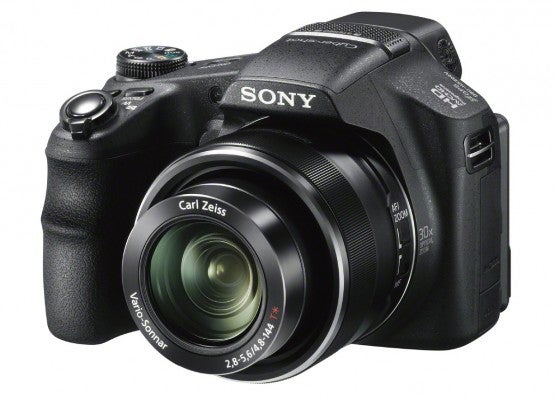Sonyu2019s latest 30x superzoom ups its imaging ante
The Sony Cyber-shot HX200V updates the HX100V superzoom. In its new guise the camera may look much the same, though the HX200 has a slight cosmetic change on account of its new textured grip finish.
The HX200V’s 30x optical zoom lens is the very same as that found in its predecessor. This offers a wide-angle 27mm that can extend through to a telephoto 810mm, controlled either by using the zoom toggle around the shutter or the manual zoom ring on the lens itself. Unlike other superzoom cameras there’s a switch to the side of the lens that toggles between manual zoom and manual focus control. It’s possible to them zoom using the zoom toggle and adjust manual focus via the lens ring, for example.
The lens is fast through its zoom range, though the zoom ring controls the lens electronically – it’s not a full manual zoom ring as per the Fujifilm FinePix HS20 – which can mean small, incremental ‘jumps’ between focal ranges rather than absolute pin-point precision. Optical SteadyShot image stabilisation helps keep shots sharp and is particularly useful at the longer focal ranges where it’s tricky to keep the camera steady.
However, we would have liked a wider-angle 24mm setting for this latest release to keep it in line with most competitors’ superzoom cameras on the market.
The biggest change comes in the form of the HX200V’s latest 18.2-megapixel, 1/2.3in CMOS sensor. This increases the resolution from the 16.2-megapixels of the previous HX100V model, and maintains Sony’s back-lit Exmor R technology. Sony’s Paul Genge claims this new sensor is twice as sensitive at the sensor level, which translates into a much cleaner signal and, therefore, higher quality images with, Sony claims, one sixth the image noise of the previous model.
When WDC reviewed the HX100V in May 2011 we did note that the highly-populated sensor did, in part, hinder the final quality – so for the HX200V to introduce yet more pixels is a bit of a risk in our eyes. For pre-production shots, take a look at our preview gallery.
The HX200V has a 1080p (50fps) HD movie mode can be accessed via the one-touch movie button, and it’s now possible to capture 13-megapixel, 16:9 stills during movie recording without interrupting the recording.
On the HX200V’s rear is a 920k-dot Xtra Fine LCD that has a wide viewing angle and is mounted on a tilt-bracket for vertical adjustment. This makes for easy overhead or waist-level shooting, though therer’s still no sign of a full vari-angle bracket system.
To complement the screen is an Electronic Viewfinder (EVF) with an eye-level sensor to automatically activate it for use. Although this is very useful for using at more telephoto zoom lengths for stabilisation and for counteracting glaring sunlight, the viewfinder itself is a rather small 0.2in in size and has a lowly 201k-dot resolution. It’s not going to compete with the likes of the (admittedly more expensive) Fujifilm X-S1.
The HX200’s ‘V’ designation indicates that the model also features GPS technology. Global Positioning Satellite can be used to add location-based metadata to images that’s useful for cataloguing or interacting with up-to-date web technologies for map placement and the like.
Sweep Panorama also sees an update: the HX200V’s mode is now able to capture shots through a full 360 degrees, in addition to the existing high resolution Sweep Panorama HR and 3D modes.
Overall the HX200V looks like a decent superzoom. Granted it’s a small update over and doesn’t represent the big jump made between the HX1 to HX100V. Assuming the image quality betters its predecessor it’ll be a fine addition to the range.
There’s no final word on pricing, but based on last year’s model’s £429 launch price, we anticipate that the HX200V will carry a similar price. Availability is also unconfirmed, though a late April release date seems most likely.





